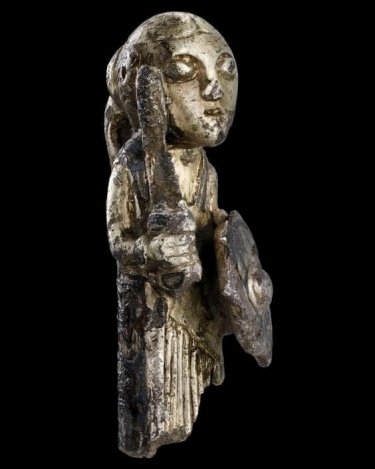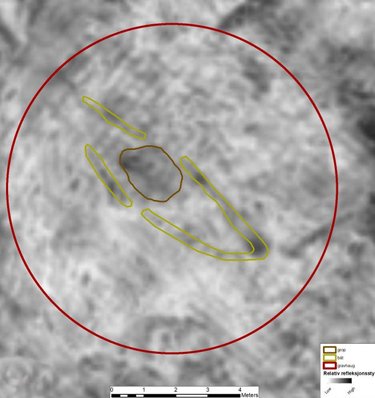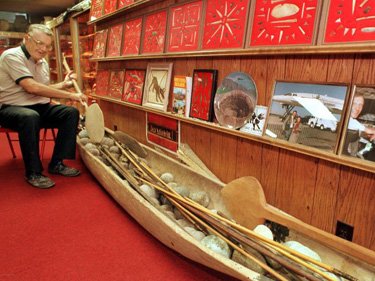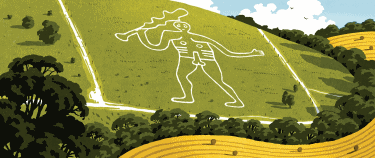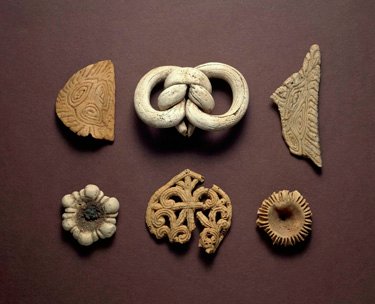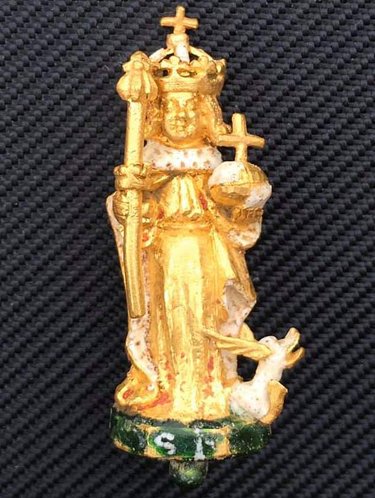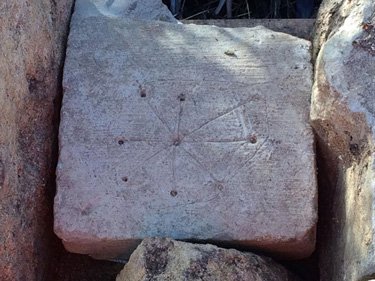Valkyrie Found
Archaeology, Denmark, Valkyrie
When amateur archaeologist and metal detectorist Morten Skovsby uncovered this tiny silver figurine near the village of Hårby in the southwest part of the Danish island of Funen, he knew exactly what to do. He documented the findspot immediately, and then took the artifact to the City Museum in nearby Odense. When the museum’s curator, Mogens Bo Henriksen, saw the figurine, he knew what it was. “There can hardly be any doubt,” he says, “that this depicts one of Odin’s valkyries.”
Norse myths, called sagas, tell of female figures called valkyries (from the Old Norse valkyrja meaning “chooser of the slain”). The valkyries were sent to battlefields by the god Odin to select which fallen warriors were worthy of afterlives in Valhalla, filled with feasts of wild boar and liquor milked from goats. Despite their prevalence in the sagas, depictions of valkyries are relatively rare. They are confined to Swedish picture stones dating to about A.D. 700 and a handful of Early Viking fibulae (brooches) from Sweden and Denmark. So this three-dimensional representation is unique.
The figurine, which would probably have been a pendant, is partly gilded, while other areas are colored black by niello, a mixture of copper, silver, and lead sulphides used as an inlay. The valkyrie wears a long patterned dress and carries a double-edged Viking sword in her right hand and a shield protecting her body in her left. Dating to about A.D. 800, the figurine was recovered near an excavated area known to have been a metal workshop. Perhaps, says Henriksen, it was discarded as waste. Or maybe it was raw material on the way to the melting pot. “For some unknown reason it didn’t make it that far—and that’s our good luck.”
Source: JA Lobell. Archaeology Magazine
Buried Viking Ship Discovered By Ground Radar In Øye, Norway
Archaeology, Norway, Ship Burials, Vikings
A new Viking Age ship has been discovered by archaeologists in Norway during a ground-penetrating radar (GPR) survey. This exciting find reveals a huge Viking boat buried beneath the ground in Øye, in Kvinesdal. …
Archaeologists from the Norwegian Institute for Cultural Heritage Research (NIKU) said the ancient boat was spotted while researchers conducted geophysical surveys in the area as part of the road-building project E39 led by Nye Veier.
The surveys are a part of the research project “Arkeologi på Ney Veier” (Archaeology on new roads). Based on preliminary reports, archaeologists estimate the Viking boat to be between 8 to 9 meters long.
Niku researchers inform that in addition to the boat burial there are traces of several other burial mounds.
At present, it is still unknown how much of the Viking boat remains. Excavations must be carried out and hopefully, the new road project will not interfere with archaeologists’ work.
Your Tax Dollars at Work
Archaeology, Artifact Repatriation, Don Miller, FBI
Back in 2013, the FBI found a 91-Year-Old real life Indiana Jones, who’d been collecting archaeological artifacts all over the world over the course of a long life, and who had assembled a gigantic personal collection.
Recent laws, of course, have pretty much banned amateur collecting (professionals with degrees were jealous) and there’ve been also “Feel-good” bills requiring the repatriation of things found buried in the ground to the kleptocrat rulers of the chauvinistic banana republics from which they originated or mandating the return of human bones to any Amerindian group claiming them as “ancestors.”
Miller’s huge collection consisted of all kinds of things having an enormous variety of origins, but that did not stop the FBI. They showed up with a 100-page search warrant, threatened the doddering old guy with jail-time, and persuaded him to allow them to take anything they chose.
They took away 2000 bones and 7000 artifacts, so many that they had to set up their own temperature-controlled facility to house the stuff. And then they spent the next seven years repatriating objects to places like China! and Haiti (whose officials were puzzled because nobody had ever repatriated anything to them before and they had no idea what to do with the stuff). G-men also toted off bones to highly-remotely-connected Indian tribes so that prayers and food offerings could equip the ghostly owners of aged bones for passage to the Happy Hunting Grounds.
There’s the modern regulatory, bureaucratic state in action for you. If it isn’t compulsory, it’s got to be illegal. And nothing is too good for any whining identity group or bad cause.
Vanity Fair indignantly calls the late Mr. Miller a “grave robber,” but so isn’t every archaeologist?
Slideshow of 44 examples from Don Miller’s Collection.
What Else Is Under There?
Archaeology, Britain, Buckinghamshire, Church of St. Mary the Virgin, Stoke Mandeville
The site of the former Church of St. Mary the Virgin in Stoke Mandeville, Buckinghamshire, built in 1080, disused since the 1880s, and demolished in the 1960s, is going to be part of the route of a new High-Speed Railroad Line connecting London, the Midlands, the North and Scotland. But construction was delayed to allow archaeologists to first have a crack at excavating the former church site.
First, they found that the Norman Church had been built on the flint foundations of an earlier Anglo-Saxon Church. BBC 9/21/21 story
And the discoveries keep on coming. Guardian 10/29/21 story
Roman statues of a man, woman and child have been uncovered by archaeologists at an abandoned medieval church on the route of the HS2 high-speed railway.
The discovery was “utterly astounding”, according to Rachel Wood, the lead archaeologist at the site in Stoke Mandeville, Buckinghamshire. “They’re really rare finds in the UK,” she said.
“The statues are exceptionally well preserved, and you really get an impression of the people they depict – literally looking into the faces of the past is a unique experience.”
A hexagonal glass Roman jug was also uncovered. Despite being in the ground for what is thought to be more than 1,000 years, large pieces were intact. The only known comparable item is a vessel on display in New York’s Metropolitan Museum of Art.
The statues were unearthed at the ruins of a Norman church, where a team of archaeologists has been working for the past six months.
Saint Mary’s church was built in 1080, and renovated in the 13th, 14th and 17th centuries. It was abandoned in 1880, and demolished in 1966 after being declared dangerous. Its ruins became overgrown with vegetation.
In May, archaeologists and engineers began removing the remaining structure of the church and excavating the burial ground that was in use for 900 years, with the last recorded interment in 1908.
Experts believe the location was used as a Roman mausoleum before the Norman church was built. About 3,000 bodies have been removed and will be reburied at a new site.
Wood said the discovery of the statues and jug “leads us to wonder what else might be buried beneath England’s medieval village churches.
Cerne Abbas Giant, New Yorker Essay
Archaeology, Cerne Abbas Giant, New Yorker
Rebecca Mead serves up the traditional expansive New Yorker essay on the Cerne Abbas Giant in response to recent dating efforts making the news.
The Cerne Giant is so imposing that he is best viewed from the opposite crest of the valley, or from the air. He is a hundred and eighty feet tall, about as high as a twenty-story apartment building. Held aloft in his right hand is a large, knobby club; his left arm stretches across the slope. Drawn in an outline formed by trenches packed with chalk, he has primitive but expressive facial features, with a line for a mouth and circles for eyes. His raised eyebrows were perhaps intended to indicate ferocity, but they might equally be taken for a look of confusion. His torso is well defined, with lines for ribs and circles for nipples; a line across his waist has been understood to represent a belt. Most well defined of all is his penis, which is erect, and measures twenty-six feet in length. Were the giant not protectively fenced off, a visitor could comfortably lie down within the member and take in the idyllic vista beyond.
Outline version (outside paywall).
Scientists Date Cerne Abbas Giant
Archaeology, Cerne Abbas Giant
Interesting news from the National Trust:
Generations have speculated about the age and meaning of the club-brandishing giant hewn into a Dorset hillside. Was he a depiction of the legendary demi-god Hercules, an ancient fertility symbol, or even the soldier and statesman Oliver Cromwell? Another theory holds that the figure was carved around the body of a giant who was slain by local people after he terrorised the countryside.
Now, after state-of-the art sediment analysis jointly funded by the National Trust, the University of Gloucestershire, Allen Environmental Archaeology and the Pratt Bequest, National Trust archaeologists have concluded the giant was probably first constructed in the late Saxon period.
Independent geoarchaeologist Mike Allen, whose research is helping the Trust understand more about the landscape in which the giant was created, said the result was surprising.
‘This is not what was expected. Many archaeologists and historians thought he was prehistoric or post-medieval, but not medieval. Everyone was wrong, and that makes these results even more exciting.’
Phillip Toms, Professor in Physical Geography at the University of Gloucestershire, studied the samples using Optically Stimulated Luminescence (OSL), which shows when individual grains of sand in the sediment were last exposed to sunlight. Material taken from the deepest layer (1m) yielded a date range of 700-1100AD which suggests the giant was first made by late Saxons.
National Trust senior archaeologist Martin Papworth said: “The archaeology on the hillside was surprisingly deep – people have been re-chalking the giant over a long period of time. The deepest sample from his elbows and feet tells us he could not have been made before 700AD, ruling out theories that he is of prehistoric or Roman origin.
‘This probable Saxon date places him in a dramatic part of Cerne history. Nearby Cerne Abbey was founded in 987AD and some sources think the abbey was set up to convert the locals from the worship of an early Anglo Saxon god known as ‘Heil’ or ‘Helith’. The early part of our date range does invite the question, was the giant originally a depiction of that god?’
But other samples – taken with permission from Historic England and the Secretary of State – gave later dates of up to 1560, which presented Martin and his team with a conundrum, because the earliest documented record of the giant is a church warden’s account of repairing him in 1694.
‘The science suggests he could be medieval, but intriguingly, surviving documents from Cerne Abbey don’t mention the giant. In the 16th century it’s as if the giant’s not there, and John Norden’s survey of 1617 makes no mention of him. And why would a rich and famous abbey – just a few yards away – commission, or sanction, a naked man carved in chalk on the hillside?’
Martin’s working theory is that the giant may have been a medieval creation but then – for reasons we may never know – was neglected for several hundred years, before being rediscovered.
‘I wonder whether he was created very early on, perhaps in the late Saxon period, but then became grassed over and was forgotten. But at some stage, in low sunlight, people saw that figure on the hill and decided to re-cut him again. That would explain why he doesn’t appear in the abbey records or in Tudor surveys.’
1300 Hundred Year Old Cookies
Archaeology, British Museum, China, Cuisine
If cookies go a few weeks without getting eaten, they turn weirdly soft or dissolve into fine dust. If cookies go 1,300 years without getting eaten, they get carefully preserved in a case at the British Museum.
In the winter of 1915, the British-Hungarian archeologist Marc Aurel Stein opened a tomb in Xinjiang. Known as the Astana cemetery, these gravesites were where residents of the nearby oasis city of Gaochang buried their dead, roughly between the 3rd and 9th centuries. As the membrane between Central Asia and China, and the path to the Middle East, Xinjiang has been fought over for centuries (a fight that continues today, as China uses an iron fist to control it as an autonomous province). Gaochang, meanwhile, lies in ruins. But the Astana cemetery, with more than a thousand tombs preserved in the dry heat of the Turpan Basin, tells the story of the once-prosperous ancient city.
The Astana cemetery shows how Gaochang was once a prominent stop on the Silk Road, especially for Sogdians, a people from Eastern Iran who often traveled across Eurasia as merchants. Opening the tombs, Stein found heaps of evidence pointing to Gaochang’s role as a place of “trade exchange between West Asia and China.” Though the vast majority of the dead at Astana were Han Chinese, Stein saw corpses with Byzantine coins in their mouths and Persian textiles included as grave goods.
But inside one tomb, Stein found neither of these things. Grave robbers had emptied it of everything, “except [for] a large number of remarkably preserved fancy pastry scattered over the platform meant to accommodate the coffin with the dead,” he recalled later. Stein was taken aback by the beauty of the cookies and their wide variety of shapes—flat wafers with elaborate designs, delicate, lace-like cookies, and “flower-shaped tartlets … with neatly made petal borders, some retaining traces of jam or some similar substance placed in the [center].” In the arid earth of the cemetery, the sweets managed to survive to modern day.
Today, the pastries are owned by the British Museum, as part of what Stein described as his “haul” of artifacts sent back to the United Kingdom. During his expeditions, Stein also helped himself to priceless cultural objects, such as the first-known printed book. Stein’s plundering of the Diamond Sutra caused vociferous protests in China. In 1961, the National Library of China released a statement saying that Stein’s book theft was enough to cause “people to gnash their teeth in bitter hatred.” The cookies, in comparison, are regarded more as curiosities. A 1925 article in The Times of Mumbai, describing an exhibition of Aurel Stein’s finds in New Delhi, noted how “the most remarkable of all the objects are the actual pastries deposited with the dead as food objects,” with the author writing that they closely resembled “the ‘fancies’ of a modern confectioner’s shop window.”
Metal Detectorist Finds Piece of Henry VIII’s Crown
Archaeology, England, Henry VIII, Lost Stuart Crown
A metal detectorist has found the centrepiece jewel of Henry VIII’s lost crown buried under a tree 400 years after it went missing.
Kevin Duckett, 49, made the startling discovery while walking through a field near Market Harborough in Northamptonshire.
Mr Duckett said he first thought the jewel was some crumpled tin foil from the wrapping of a Mr Kipling cake.
He told The Sun: ‘It was lodged in the side of a hole just a few inches down. I carefully removed it and knew by its colour and weight that it was solid gold.’
Historians have feared the jewel was lost forever when Oliver Cromwell ordered the crown to be melted down and sold as coins after he abolished the monarchy in 1649 and beheaded Charles I.
The 344 precious stones encrusted on the crown, valued by the then Parliament at £1,100, were sold individually.
Mr Duckett, who lives in Fleckney, Leicestershire, took the lump of gold, which also appeared to have an enamel figure on it, home and cleaned it.
He became convinced that the figure was Henry VI after he saw SH inscribed on the base.
The figurine featured five fleur-de-lys – a stylised lily linked to royalty – originally had three figures of Christ, one of St George and one of the Virgin Mary and baby Jesus.
But Henry VIII removed the figures of Christ and replaced them with three saint kings of England – St Edmund, Edward the Confessor and Henry VI.
And the crown was used at the coronation of Henry’s son Charles I.
When he fled from Oliver Cromwell after the Battle of Naseby in 1645 they travelled past the spot where Mr Duckett found the jewel.
Experts believe it may have fallen from the crown in Charles’s haste or that he decided to bury it.
If the British Museum verify the jewel’s authenticity Mr Duckett will be forced to sell it to them at a price set by an independent board.
Pompeian Fast Food Shop Discovered
Archaeology, Cuisine, Pompeii
Archaeologists in Pompeii, the city buried in a volcanic eruption in 79 AD, have made the extraordinary find of a frescoed hot food and drinks shop that served up the ancient equivalent of street food to Roman passersby.
Known as a termopolium, Latin for hot drinks counter, the shop was discovered in the archaeological park’s Regio V site, which is not yet open the public, and unveiled on Saturday.
Traces of nearly 2,000-year-old food were found in some of the deep terra cotta jars containing hot food which the shop keeper lowered into a counter with circular holes.
The front of the counter was decorated with brightly coloured frescoes, some depicting animals that were part of the ingredients in the food sold, such as a chicken and two ducks hanging upside down.
“This is an extraordinary find. It’s the first time we are excavating an entire termopolium,” said Massimo Ossana, director of the Pompeii archaeological park.
Archaeologists also found a decorated bronze drinking bowl known as a patera, ceramic jars used for cooking stews and soups, wine flasks and amphora.
Interesting Archaeological Discoveries This Year
2020, Archaeology, Global Warming

Melting Ice Reveals a Viking Mountain Pass
Gizmodo slideshows the most intriguing archaeological discoveries of 2020. They missed the Amazonian rock paintings that proved that today’s rain forest jungle used to be savannah. And, I was much amused to read the comment on the slide above:
Mittens, shoes, horse snowshoes, bits of sleds, and the remains of a dog still attached to its collar were among the many items found in a former mountain pass in central Norway. Located on Lomseggen Ridge, the pass was used for over 1,000 years, with traffic peaking around 1000 CE during the Viking Age. A melting glacier—the result of climate change—made this and similar archaeological discoveries possible. Also, climate change still sucks.
If that pass was previously exposed a thousand years ago, and used for a thousand years, long before the Industrial Revolution and the Internal Combustion Engine, doesn’t that fact suggest that the climate can change without human responsibility and without any culpability?
Doesn’t that prove that very major changes of climate, on a scale like nothing we have remotely experienced, happen perfectly normally as part of the order of Nature?
A change of climate, like any change, must inevitably feature certain downsides, but if you lived in Central Norway, do you really think warmer, milder weather and freshly open, more convenient mountain passes useable for travel and trade would necessarily suck? That perspective strikes me as conformist, unthinking, and naive.
Sundial or Witches Mark?
Archaeology, England, HS2, Witches Mark
The Bucks Herald:
Archaeologists working in Stoke Mandeville to prepare for HS2 [a High-Speed Railway] have begun the excavation of the remains of the medieval church of St Mary.
They have also discovered some unusual stone carvings, medieval graffiti and other markings.
Two stones with a central drilled hole from which a series of lines radiate in a circle have been uncovered at the site of St Mary’s.
Historians consider these markings to be ‘witches’ marks, created to ward off evil spirits by entrapping them in an endless line or maze.
There are several well-known examples of these across Britain both in churches as well as houses and sometimes even on furniture. However, they can also be interpreted as early sun dials, used by the church to divide up the day into morning prayer, midday prayer and evening prayer.
These ‘scratch dials’ as they are known, are usually found close to the southern door of the church as it is a position better suited for a sun dial.
At St Mary’s, one example of the markings was found low down in the west buttress close to ground level which has led archaeologists to question its purpose.
The position of the stone would have meant that it wouldn’t have served a purpose as a sun dial. This has left the possibility that it was there to ward off evil spirits or could have been a stone from a sun dial re-used as part of the church building. …
Archaeologists from Fusion JV working on behalf of HS2 Ltd at the site were also given the rare opportunity to excavate and carefully deconstruct the remains of the medieval church – something that has not been done in Britain since the 1970s.
The old church was built to serve the manor house and was located some way from the village centre. It was replaced in 1866 by a new church built closer to the village.
Though it was known that the church had been demolished, the method and extent of demolition had not been recorded and it was therefore a surprise to the archaeologists to discover, that beneath the rubble the church survived to a height of almost 5ft with floors intact.
Detailed research into the structure of the church has allowed archaeologists to piece together a history of the development of St Mary’s.
The church started off as a chapel built in about 1070, shortly after the Norman Conquest and may have been at first the private chapel belonging to the lord of the manor at that time. The church was soon extended, and an aisle added in the 1340s.
Archaeologists These new additions seem to mark a transition from a chapel used for private prayer to a church that was used by the local villagers.
Work to dismantle and excavate the church will continue into next year and archaeologists are looking forward to answering many more questions concerning the church and its architecture including discovering whether there may be a Saxon church lying beneath its floor.
—————————-
What is being excavated is a heap of rubble, all that remains of the Church of St. Mary the Virgin in the deserted village of the former Stoke Mandeville. The abandoned 11th or 12th Century Church was condemned and demolished in 1966.
